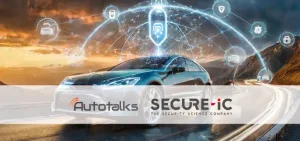Onn Haran, founder and CTO of Autotalks, argues that the best practice for accident prevention and other aims is using two networks – one for direct communication and one for cellular communication.
In the realm of automotive connectivity, hybrid communication fulfills all vehicle communication needs for safety and road-related data. It utilizes a combination of cellular and direct communication to address the limitations associated with relying on each one individually.
Direct communication, known as vehicle-to-everything (V2X) communication, enables communication between all road users in proximity without passing through a base station. All V2X standards (DSRC, LTE-V2X and 5G-V2X) can compose hybrid communication. With that, a vehicle gains real-time knowledge of the location and movement of all road users around it to prevent accidents and improve mobility. However, its value depends on penetration, which is limited, as V2X is in its infancy. Penetration is a non-issue for cellular networks, as practically all new vehicles and a significant portion of the old ones include a cellular modem.
Direct communication is available anytime, anywhere. In contrast, cellular networks have areas with poor coverage, and availability can be challenging in crowded areas. Cellular networks connect vehicles to cloud services. Both 4G or 5G can compose hybrid communication. Having said that, the introduction of 5G, network slicing and mobile edge computing increased network capacity, decreased latency and improved predictability.
On top of the communication challenges, the unification of all vehicles in a cloud should be addressed. The use of a proprietary cloud service defeats the goal of creating a cross-border network of all vehicles regardless of their make and all other road users not associated with the specific cloud provider. In contrast, direct communication is open and standardized. It is also important to note that regulations limit carmakers from sharing private information about vehicle locations.
The cellular network’s capacity isn’t designed to handle the constant high-rate transmission of all vehicles. Its capacity can’t be overwhelmed by such demands. Moreover, someone must bear the costs for all the cellular data, while direct communication is free.
Hybrid communication does not have a singular recipe, but guidelines can be suggested:
- Vehicles should have a single processing path for data, whether it comes from direct or cloud communication. To accomplish this, a single identical data format should be used, such as uniform lane-counting area definitions. The event-triggering conditions (for instance, when an accident is detected and then removed) should be identical. In Europe, DATEX II is the common language. In other regions like the U.S., a common language must also be adopted.
- The cloud system should be open to multiple data suppliers, including different ambulance operators, regional road authorities and all OEMs. In Europe, NAPCORE accomplished this through a decentralized system. A National Access Point (NAP) concentrates and publishes transport-related data, offering EU-wide interoperable travel and traffic services to end users. A similar initiative is needed in the U.S.
- Cellular communications services should be as broad as possible and conditioned by common availability—in other words, picking all possible services that are consistently widespread. NAPCORE is a great baseline: It covers traffic conditions, accidents/incidents, safety-related traffic information, management and regulations, truck parking, refueling and recharging infrastructure.
- A service can use a single or both networks, given that the network can meet the requirements. Specifically, safety services, using real-time high-availability data from nearby road users, should use only direct communication.
Several examples illustrate applying the guidelines on different services. Road-blockage notification can be supported only by cellular communication. Warning of roadwork can be provided locally via direct communication or globally through a cloud, using the same data format and triggering conditions. Using V2X, the warning will be received within about 1 km from the roadwork, allowing the driver to switch lanes safely. Using the cellular network, the driver would be able to select an alternative route.
Also, a post-crash notification can be provided by both networks. But the goals are different. The cellular network allows the first responders to arrive at the scene and save lives. The cellular networks can also alert drivers far in advance so they can select a different route. Direct communication informs nearby drivers about the accident so they can slow down and prevent a pileup.
Emergency vehicle safety is more complex, as it involves interactions with various actors:
- Traffic lights: Emergency vehicles can use both the cellular network and direct communication to preempt and prioritize the traffic-light phase. However, if the emergency event causes a traffic jam, the cellular network could be overwhelmed; therefore, getting a cellular signal could be a challenge.
- Emergency vehicle alerting vehicles ahead: An emergency vehicle can indicate its presence using a cellular network. But to know if the emergency vehicle had changed lanes, real-time–assured low-latency communication is needed, and this is possible only with direct communication.
- Emergency vehicle alerting vehicles approaching an intersection: Similarly, direct communication is needed to know the exact distance of an emergency vehicle from the intersection.
- Emergency vehicle receiving alerts about nearby vehicles or cyclists: An emergency vehicle approaching an intersection with a red light should be alerted if the intersection isn’t vacant. Only direct communication can be used to issue such notifications.
Lastly, crash avoidance can be accomplished only by using direct communication. Automatic braking based on V2X doesn’t involve the cellular network.
The examples illustrate how the two networks complement each other in providing safety and assistance data. Instead of looking at each separately, we should work together at finding ways to combine them, like peanut butter and jelly that together elevate each other. The integration of an open cloud system with direct communication enhances safety and driver convenience.






